by Editor | Aug 19, 2013 | Luxury Travel

Taking Root in Provence by Anne-Marie Simons*
Anne-Marie Simons and her husband Oscar were self proclaimed gypsy souls who decided to settle down somewhere during their early retirement. In 1998, the couple set out to find a home that offered pleasant weather, culture, natural beauty and access to international travel. They found their requirements in a French urban setting, Aix-en-Provence, where they have been living full-time ever since.
Simons authored Taking Root in Provence (Distinction Press, $15.95), a 208-page softcover book about their life in Provence, France published in 2011. The easy to read book is divided into 40 short chapters followed by 13 of Oscar’s regional recipes. She discusses various aspects of their life in Aix-en-Provence from the market, their apartment chimney, how they buy truffles from a restaurant owner to avoid the ubiquitous Chinese impostors, to Christmas in Provence and more. In the closing chapter, she draws attention to things that may surprise foreigners such as public urination of children and adults so common no one notices, air kisses, bare breasted sunbathers at the beach, well behaved dogs in restaurants, and the “national craze” for food.
She estimates 35,000 anglophones make the region their home. Many of them belong to the Anglo-American Group of Provence.
“They have a bridge club, a hiking club, clubs for gardening, cycling, cooking, etc. This is a great help to those who do not speak French and makes the transition easier. Also, this group tends to favor the countryside over the city, and most have bought homes with gardens and swimming pools which are being put to good use given that the local climate allows you to eat outside during a good part of the year. For many of these people Provence is a second home and they often have held on to a foreign address,” she said by email.
When asked about changes in her area resulting from the economic downfall she responds, “If much has changed since the Great Recession, it seems to have had little effect on Aix-en-Provence and our region. There are as many tourists as ever but perhaps I am hearing a bit more Russian and Chinese (the deepest pockets). If some shops are closing, others quickly take their place; restaurants and bars are still full; and our opera festival sold out, as usual. The change seems to be elsewhere: there are factory closings in France and I hear that the Chinese are buying up French wineries, especially in the Bordeaux area. Real estate has been affected also: houses are not selling like before and there is quite a bit of supply.”

Anne-Marie Simons, author, Taking Root in Provence, and her husband Oscar Rodriguez-Rozic*
“What we like best? Without a doubt: the quality of life. We may have different tastes and interests, but I don’t know anyone who would not like to live in an environment of great natural beauty and a climate with 300 days of sun a year; daily markets; very good public service (national healthcare, education, public transportation), and subsidized culture which is at least partly responsible for the fact that we have five bookshops and three movie theaters in the center of Aix (while they are leaving city centers in the U.S.). Proximity to the Mediterranean and the abundance of healthy fresh produce directly from the farm are added pleasures.”
When asked about the possible impact of taxes on the wealthy she said, “There’s been a lot of talk about the high taxes in France including celebrities that have moved to a neighboring country to save taxes. What has been your experience in that regard?” she replied: “This has not affected us at all. When the Socialist candidate François Hollande won the presidential elections last year, one of his campaign promises had been that he would ‘tax the rich’ by putting a 75 percent income tax on all private income over €1 million per year. Since I am not in that category (nor are most of the retired expatriates here) this threat did not concern us and, in fact, has since been rejected by the French Supreme Court as discriminatory. People like French actor Gérard Depardieu and businessman Bernard Arnault who both moved to neighboring Belgium and applied for citizenship there to avoid this tax hit at home, have become a ’cause célèbre’ and attracted a lot of attention. Predictably, this political issue was called an ‘invitation to tax flight’ by the right and ‘a call to solidarity when the country is in financial straights’ by the left, and has since died down. Ever since this tax on the rich was declared illegal, the French Finance Minister has announced that he will rewrite and resubmit the 75 percent tax requirement to suit the existing tax laws, but this will take time and now that everyone is forewarned there will surely be few “victims”. In short, this issue has come and gone and is no longer talked about.”
Simons work experience includes translator, teacher, director of corporate communications and journalist. She writes ProvenceToday.blogspot, a blog about Provence. Her husband is a former international development banker now dedicated to Provencal cooking among other things.
*Book cover photo courtesy of Taking Root in Provence media page and photo of author and her husband courtesy of Marie Hennechart Photography
by Editor | Jan 1, 2013 | Luxury Travel

From all of us at Simon & Baker Travel Review and Luxury Travel Review best wishes for a healthy, happy and bountiful 2013!
by Editor | Nov 19, 2012 | Luxury Travel

Costas Christ, chairman, international team of judges WTTC
Each year the World Travel & Tourism Council* (WTTC) recognizes innovative pioneers in sustainable tourism, following a three-step judging process including on-site evaluations of all finalists. The Council selected a panel meant to reflect all areas of the global Travel and Tourism industry including the private sector, academic institutions, non-profit organizations and government. This year the chairman of the international team of judges will be Costas Christ.
As part of the process the judges are expected to select a shortlist of 12 finalists by January 21, 2013. During the second stage of the process they will visit the properties and destinations for on-site evaluations.
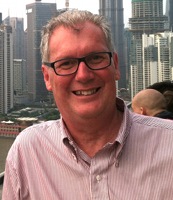
Tony Charters, principal, Tony Charters & Associates
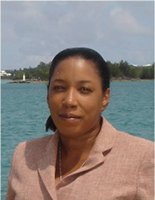
Gail Henry, sustainable tourism product specialist, Caribbean Tourism Organization

Clara Ines Sanchez Arciniegas, vice minister, Colombia

Mahen Sanghrajka, chief and founder, Big Five Tours & Expeditions
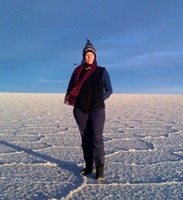
Pegi Vail, professor, Colombia University

Jalsa Urubshurow, CEO, Nomadic Expeditions and Three Camel Lodge
Following the on-site evaluations, the finalists are scheduled to progress into the last stage of the judging process. A separate Winner Selection Committee is expected to meet after a detailed review of the finalist judges’ recommendations, the award applications, and the on-site evaluation report, selecting one winner in each Award category. Organization representatives should announced the winners during the awards ceremony of the WTTC Global Summit on April 9, 2013 in Abu Dhabi, United Arab Emirates. Applications for the award are due by 26 November 2012.

Marilu Hernandez, president, Fundacion Haciendas del Mundo Maya
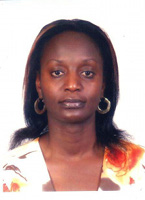
Judy Kepher-Gona, executive director, Base Camp Foundation
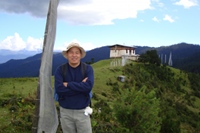
Karma Tshering, chief, Nature Recreation and Ecotourism, Department of Forests and Park Services, Bhutan

Mandip Singh Soin FRGS, managing director, Ibex Expeditions (PVT) Ltd
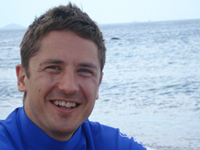
Graham Miller, head, School of Hospitality and Tourism Management, University of Surrey
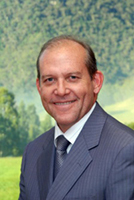
Tony Williams, director, Hospitality Operations, Qatar Foundation
This year’s judges are Clara Ines Sanchez Arciniegas, vice minister, Sustainable Tourism Development, Ministry of Commerce, Industry and Tourism, Colombia; Gail Henry, sustainable tourism product specialist, Caribbean Tourism Organization, Barbados; Graham Miller, head, School of Hospitality and Tourism Management, University of Surrey, United Kingdom; Jalsa Urubshurow, chief executive officer, Nomadic Expeditions and Three Camel Lodge, Mongolia; Judy Kepher-Gona, executive director, Base Camp Foundation, Kenya; Karma Tshering, chief, Nature Recreation and Ecotourism, Department of Forests and Park Services, Bhutan; Mahen Sanghrajka, chief and founder, Big Five Tours & Expeditions, United States and Kenya; Mandip Singh Soin, founder and managing director, Ibex Expeditions (PVT) Ltd, India; Marilu Hernandez, president, Fundacion Haciendas del Mundo Maya, Mexico; Pegi Vail, professor and sustainable tourism documentary film maker, Colombia University, United States; Tony Charters, principal, Tony Charters & Associates, Australia; and Tony Williams, director, Hospitality Operations, Qatar Foundation, Dubai.
The World Travel & Tourism Council (WTTC), a forum for business leaders in the travel and tourism industry, strives to raise awareness of travel and tourism as one of the world’s largest industries, supporting 255 million jobs and generating 9 per cent of world GDP. The Simon & Baker Travel Review is a Media Sponsor of the WTTC Tourism for Tomorrow 2013 Awards.
*Photos courtesy of World Travel & Tourism Council
by Editor | May 14, 2012 | Luxury Travel
By Elena del Valle
Photos by Gary Cox
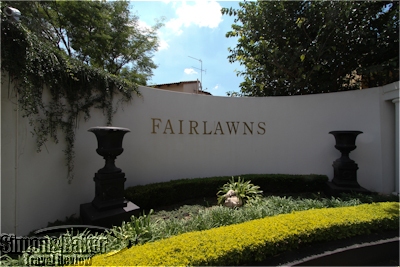
The entrance to Fairlawns
Tucked within a high end neighborhood in South Africa’s busy metropolis the Fairlawns Boutique Hotel & Spa offered a myriad amenities desirable to tired travelers like us. While we were familiar with several airport hotels which were more convenient the pretty grounds and luxury features of the Fairlawns appealed to us. As I sat on the grueling 15-hour flight from Atlanta, Georgia to Johannesburg, South Africa I dreamed of the comfortable bed, spacious bathroom with a shower and bathtub, quiet ambiance, and room service I would enjoy on arrival. We had stayed at the property previously and were confident it would serve our needs on this brief one night visit (see Pretty Johannesburg boutique hotel, spa in quiet residential neighborhood).

The Villa Suites building
We requested an airport pick up in advance to avoid the hassle of a car rental since we planned to be in the city less than one day. As we exited the busy arrivals hall at the airport I spotted our driver easily. We rode in air conditioned comfort into the city and less than an hour later we had settled into our accommodations for the night at the 40-room four acre hotel with 60 staff. Although the hotel restaurant and its new chef were a draw after so many hours of travel what I yearned for was a simple salad or sandwich while sitting comfortably in my bathrobe following a decadently hot shower or luxuriant bath.

A view of the restaurant at night
The Toulouse Suite, Suite 39 in the Villa Suites building, delivered all that I had longed for on the flight and more. It was the first time we stayed at the Villas Suites, the newest of the buildings at the property, built behind and to the right of reception before the much anticipated 2010 World Cup.

The Toulouse Suite
Our Deluxe Suite had the varied decorative touches and many luxury amenities we had liked in the past such as embroidered linen, stocked mini bar, and fruit plates. The 82 square meter room, one floor up from the ground floor via an elevator or a spiral staircase, was kept at a comfortable temperature with individually controlled air conditioning (and underfloor heating in the winter months).
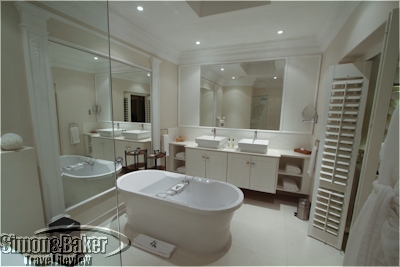
The bathroom was large with tub and shower
It was furnished with two double beds resting against off white fabric headboards and topped with a crisp white duvet with the Fairlawns logo. Although the room had an unremarkable view to a service walkway on the side of the building it was blissfully quiet, the most attractive feature for us the night we arrived. Double curtains covered the windows, providing privacy at night and shade from the fierce daytime sun. Antique style wood and marble top tables with matching glass bottomed lamps served as night tables. To one side there was an antique style wood desk with a beige stool where we set our computer and electronics during our stay.

A comfortable seat and snacks
On the floor a putty colored carpet felt soft against our tired stockinged feet. Should we wish to make a call there were handheld wireless and regular phones. While we waited for room service to deliver our dinner order we sampled the fruit plate and a plate with mixed nuts and tasty biltong (South Africa dried beef) courtesy of the hotel. In the mini refrigerator there was complimentary cold still mineral water, juice and two dried mango snacks.
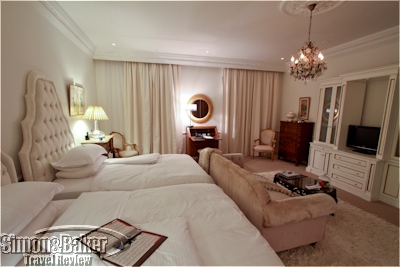
A view of the room from the corner next to the bathroom
In front of the bed, on the right side of the single ambiance room, there was a putty colored sofa atop a white rug facing a glass topped wood coffee table. Across from the table was an entertainment section with a Hi Sense flat screen television in the center and the mini bar to the lower right. Antique framed silk birds and landscapes adorned the walls and in the center, an elaborate chandelier with a porcelain flower motif hung from the ceiling. There was a stand alone wood armoire where we hung some of our clothes after the bell hop set our suitcases on the large luggage rack near the entrance.

The Villa featured pretty common areas
The next morning we awoke refreshed and ready to face the day. There was complimentary coffee and tea service on the first floor across from our suite. After checking emails with the complimentary WiFi services I headed to the spa for a work out (there was a spacious fitness section with treadmills, exercise machines and free weights within the spa building, I remembered from past visits). Next we enjoyed the lovely breakfast buffet and hot made to order options. On the long table, covered with a cloth to keep the flies off, there were fresh fruit plates, breads and pastries, jams, yogurt, cheese, salmon, and deli meats. The staff were friendly and attentive.
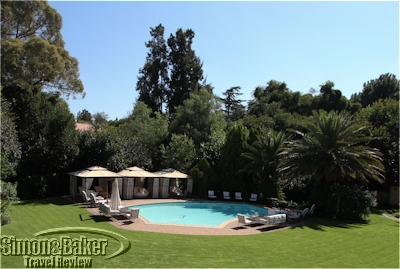
The pool area at Fairlawns
From our window side table we had an expansive view of the central lawn and pool area. I felt like I could have stayed there the whole morning. Instead I donned by bathing suit and lounged poolside for the better part of an hour. I even managed a swim in the chilly water. While chatting with a fellow guest one of the staff from breakfast walked down to check on us, politely offering beverages and snacks. We had both had our fill at breakfast and declined.
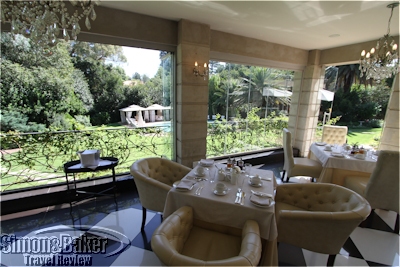
The dining room at breakfast looking out over the property
While I was at the pool a kind staff person ironed my linen clothes and by the time we left I looked rested and presentable, a concept that was hard to imagine while I was breathing stale air on the airplane less than 24 hours earlier. That rested state is one of the reasons the Fairlawns Boutique Hotel and Spa (91 Alma Road, off Bowling Avenue, Morningside, Gallo Manor, Sandton 2052, Johannesburg, South Africa, +27 11 804 2540/1/2/3, +27 11 808 7300 or +27 73 481 7734, http://www.fairlawns.co.za/, fairlawn@fairlawns.co.za) remains on our list of favorite boutique hotels in Johannesburg.
by Editor | May 7, 2012 | Attractions, Luxury Travel
By Elena del Valle
Photos by Gary Cox
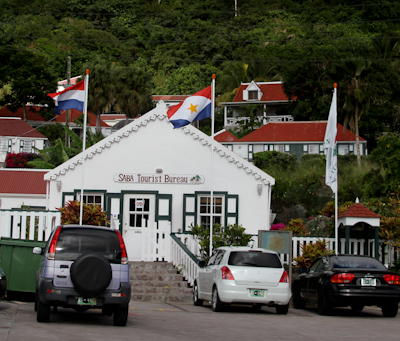
The Saba Tourist Bureau
I loved Saba, a small Dutch Caribbean island, for its unspoiled and picturesque character. What this volcanic Leeward Island lacked in size it made up for in beauty, natural features and sheer determination. For example, the islanders were told by experts in Holland early last century that it was not possible to build a road due to the steep incline of the mountains. Refusing to accept that ruling one man took a correspondence course and with the help of his fellow islanders built the beginning of what today is called simply The Road.
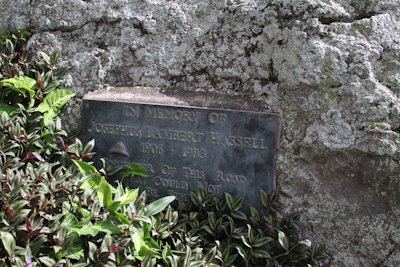
A plaque to Josephus Lambert Hassell, engineer of the road
With a population of less than 1,500 and diminutive (it occupies five square miles), the tourist attractions were mainly scenic, we expected before visiting the island. Cars were scarce in Saba. We had a few hours to see what we could while our ship, the SeaDream I, stopped there and we intended to make the most of it. With a little help from the crew we were able to find a taxi, the only one available that day apparently. The driver, a friendly Irishman who had relocated to Saba only a few months earlier with his van (the windows in the rear of the van did not open we later discovered with disappointment), explained that he would be pleased to show us around the island if we were willing to share space and wait for him.
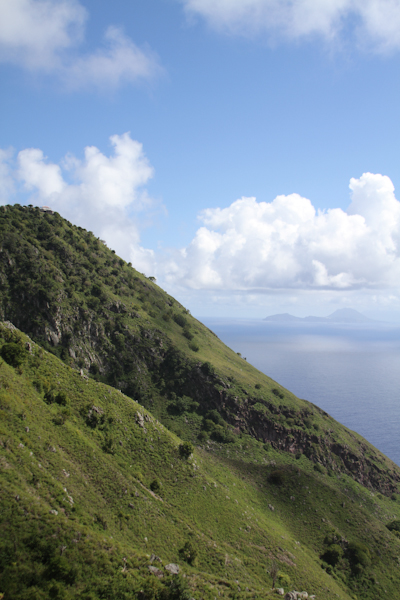
Saba in the foreground and remote islands on the horizon
Six of us shared the van up the narrow and steep roads. He dropped two of our group at the entrance to a hiking trail (they reported having a wonderful time later when we met up aboard the ship) before leaving us in The Bottom, the island’s main urban area. He would take care of local customers (many of the medical school students were going on vacation and there was a wedding the next day) who had booked his services already and return for us about 90 minutes later.

We stopped at this church with a view
When he returned he had a glass of fresh made fruit juice with us before the four of us climbed into his van to see the sights. Minutes later we felt transported back in time when we stopped at a small church with a million dollar view. Although the church was closed there was a kind lady running a simple small cash only shop behind the church. She sold handmade lace in the tradition and style of Saba, a dying art, our driver shared as we departed having bought one of the treasured lace pieces.

The tiny Saba airport
From there we drove downhill toward the waterfront island airport. On our way back our driver showed us the house he rented as we drove by it on way back toward The Bottom and the dock where we had arrived.
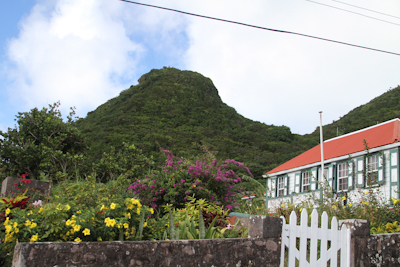
Cute little houses and flowers dotted the hills
Earlier while we waited for our guide and driver to return we had made our way around the hilly village, picking up tips and information at the tourist office where a friendly staff person welcomed us, passing a cafe and small indoor market and walking up a steep hill toward JoBean Glass unsure if it was open for business. Our efforts were rewarded when we arrived at the un-airconditioned shop and found it open. A shy young lady inside said we were welcome to browse around at our leisure. Every surface, every corner of the shop was filled with glass items, many made from Venetian glass, we later found out from the friendly owner who popped by for a few minutes.
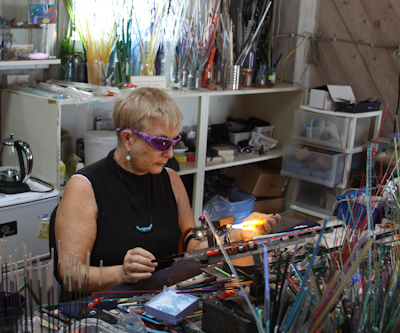
JoBean Chambers demonstrating a technique to fashion colorful glass jewelry
JoBean Chambers, a lively and vivacious American woman who had lived and worked on the island for many years, showed us the glass pieces she was making for the wedding we had heard about, and gave us a brief glass making demonstration. Watching her flame work the thin and colorful glass tubes it seemed easy to create pretty seahorses, turtles, frogs, fish, mermaids, dive flags, starfish and other attractive shapes. She would heat and swirl the glass quickly and easily (for her), then attach another piece of glass in a different color to the incipient shape, adjusting the width and style along the way. In moments we could distinguish a multicolored frog and after that a mermaid. It was hard to imagine the glass melts at temperatures of more than 2,000 degrees Fahrenheit.
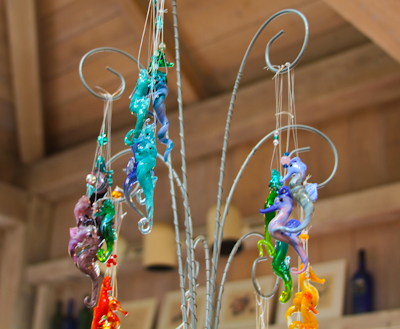
Many of her glass creations were sea creatures
A fan of hot glass since 1989 she had learned her skills, in part at El Vetro in Venice, Italy where she studied, according to her website, with Lucio Bubacco and Vittorio Constantini. Her work was exhibited in art galleries in the United States and the Caribbean, including the Corning Museum Shop. She offered glass workshops in her hillside studio for up to five students at a time. Next time we visit Saba maybe we will take one of her workshops.

Our visit to Saba was a special treat and one of my fondest memories from our week long Caribbean cruise. This was in part because of the pretty hillside houses in the small towns, the old style lace sold behind the church, our shared taxi tour and fun stop at JoBean Glass Art Studio (Booby Hill, Windwardside Saba, Dutch West Indies,+ 599 416 2490,www.jobeanglassart.com, jobean@jobeanglassart.com).
by Editor | Apr 16, 2012 | Accomodations, Luxury Travel
By Elena del Valle
Photos by Gary Cox
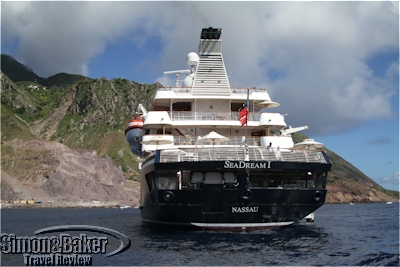
The SeaDream I
Last December we spent a week aboard the SeaDream I making our way between small Caribbean islands. As with the European SeaDream II voyage we took in the past what we liked most was the intimate ambiance, gourmet offerings and service orientation of the all-inclusive luxury voyage.
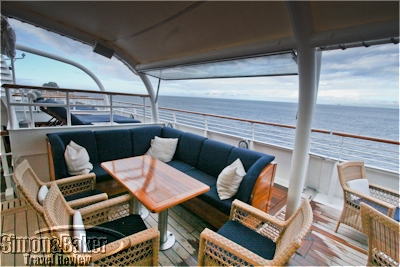
A great spot for morning coffee near the Top of the Yacht bar
We were half full with 54 passengers and nearly a full crew compliment of 94 aboard the 344 feet long vessel with a 47 foot beam. Although our ship was small and offered a limited variety of entertainment options compared to the mega cruise ships with scores of decks, multiple restaurants and facilities and thousands of passengers and crew that now pepper the oceans it was the perfect size for a small group such as ours. While there were fewer activities than aboard larger vessels there were enough options to meet our desires. We were pleased to relax and meet some of the other passengers at happy hour, meal times and between shore excursions.
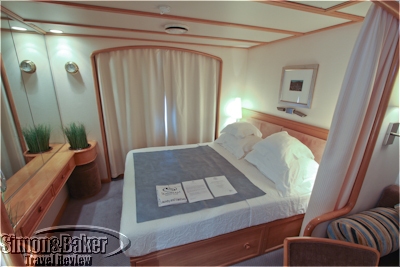
Our cabin on the SeaDream I
One of the hallmarks of SeaDream is service. When we arrived at the dock on our way to the ship, as we were exiting our taxi, an energetic young man from the ship, in uniform, approached us and introduced himself purposefully. He immediately coordinated the delivery of our luggage and escorted us through the security point. That kind of friendly and efficient service was repeated on board. That first impression set the tone for the remainder of the trip.
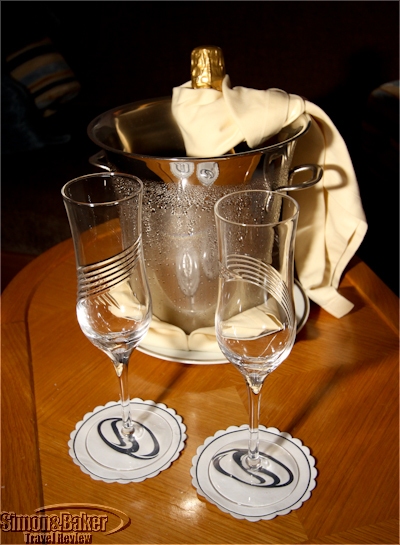
Welcoming bubbly on ice
The size of the group and ship offered myriad advantages we enjoyed. Aboard the ship there were never crowds, lines or reservations necessary for meals. Staff and even fellow guests could often easily recognize each other. Nearly all the staff we encountered greeted us and other guests by our names during that week.
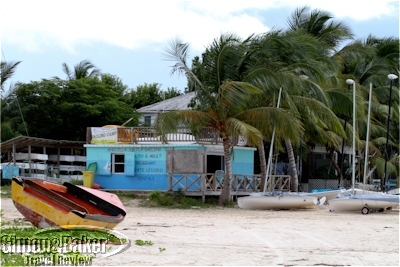
On the beach in Anguilla
At anchor we were often the only large vessel at the places, several of them off-the-beaten-path islands, we visited. As we walked along the beach in Sandy Ground, Anguilla a local couple we spoke with commented that it was rare to see ships in that area. In Saba, we heard from the crew and the locals that often inclement weather prevented access to the island and few large ships stopped there. Although the weather had been dubious at times Lady Luck smiled upon us that day, making it possible for us to explore the tiny and picturesque Dutch island.
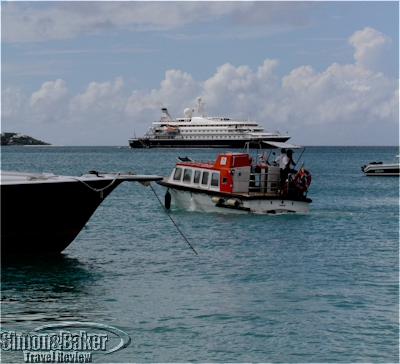
The SeaDream I tender heading out to the yacht
Another benefit we appreciated were the speedy and comfortable shore transfers within covered tenders. We became aware of the difference when observing fellow passengers from a similar ship embarking and disembarking, partly wet, from their ship’s dinghy when we went ashore completely dry and in the superior shelter and comfort of our small water craft.

Grilled lobster tail on a bed of vegetables
What we noticed and many experienced cruise aficionados in our group shared with us was how special the meals were aboard SeaDream I. Food, as is common aboard cruises, was abundant. Meals, often plated and prepared a la minute, were outstanding. Gilles de Cambourg, executive chef, Ferenc Béres Molnar, pastry chef, Pablo Raschetti, sommelier, and the dining service staff went the extra mile to ensure our meals were delicious and well served, every time. There was even a celebrity chef from the United Kingdom, Levi Root, spicing things up aboard that week. The quality standards extended to room service meals. Twice we ordered from the in-room dining menu; both times the dishes were well prepared, well presented and served within minutes of our order.
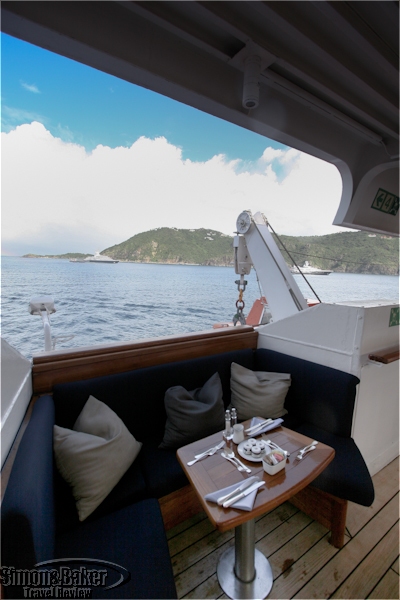
A favorite breakfast and lunch dining spot
We will keep Sea Dream yachts at the top of our list for luxury, laid back, all-inclusive, service and gourmet oriented intimate sea voyages and recommend them to friends who share our appreciation for cozy luxury voyages. Click here to read more about our week in the Caribbean aboard SeaDream I.


















































